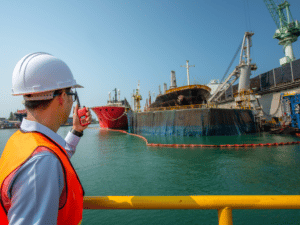The maritime industry encompasses a variety of fields that ranges from the transportation of cargo and passengers to the harvesting, processing, and delivery of seafood from the sea to the many ports and sea terminals. These various branches of maritime business depend heavily on a vast array of tools and heavy equipment that help seamen and longshore workers perform their jobs on time and more efficiently. Many of these essential tools, including cranes, conveyor belts, and trawl winches, are dangerous to work around and often injure or kill maritime workers.

Maritime Cargo and Crane Injuries
Maritime cargo accidents can occur at any point of a vessel’s itinerary. They may happen at a port or sea terminal during the loading or unloading process, or they may take place at sea. On land, one of the most dangerous maritime jobs entails the use of cranes and other heavy-lifting equipment.
According to the Occupational Safety and Health Administration (OSHA), 1 in 1,000 maritime crane operators will suffer a fatal injury on the job. Most cargo-related accidents can be prevented by proper maintenance and training, but all too often employers focus on the bottom line and neglect these areas. As a result, a majority of cargo-related accidents are caused by mechanical failure or operator error.
Maritime Conveyor Belt Injuries
Conveyor belts are essential tools used in the maritime fishing industry to load freshly caught fish into factory ships’ processing areas and move the frozen products in and out of the cargo holds. Conveyors assist fishing boat crews with time-consuming and difficult tasks, but their multitude of pulleys, gears, and other moving parts makes them dangerous to work around.
Maritime workers suffer severe injuries or are killed in accidents involving conveyor belts when their clothes get snagged in the machinery. The most common causes of conveyor belt accidents include improper guarding, inadequate training of personnel. and failure to keep the machinery in good working order. In most instances, these conditions are a direct result of negligence and carelessness on the part of the maritime workers’ employers or the vessel owner.
Maritime Fish Processing Equipment Injuries
Deep sea fishing trawlers and factory ship workers are at risk almost every time they work. In addition to facing hazards of rocky waters while working long hours, they are also in danger of chemical exposure, overexertion, asphyxia from working in confined spaces, and puncture wounds.
Fractures and head and neck injuries are also common for fish processors, according to a study performed by the National Transportation Safety Board (NTSB).
Maritime Ladder and Step Injuries
Although ladders are a convenient way for maritime workers to access higher levels and climb aboard vessels, they also pose a great danger, especially if there are broken steps or rails. Since seamen usually fall from extremely high areas during a ladder and step accidents, the consequences are often fatal. In fact, the United States Navy suggests that falling from heights is the leading cause of death in almost all industries in the U.S.
The most common reasons for maritime ladder and step injuries include a poorly designed ladder, broken parts, lack of safety training, and structural flaws.
Maritime Plate Freezer Injuries
Plate freezers are used to keep seafood at the correct temperature, usually between 30 to 40 degrees below zero. At the same time,however, this places workers at risk of developing hypothermia and/or frostbite.
In addition, workers may be in the crosspath of flying plate freezers if the vessel sways or moves suddenly. On average, plate freezers weigh around 30 pounds, which makes it easy for them to become airborne. Despite their light weight however, the impact of the plates if they hit workers can be severe, and may lead to cuts, head injuries, concussions, bruising, lacerations, and more.
Shipboard Fires
Fires aboard ships are the most feared hazard for seamen, ship owners, captains, and passengers. Ships of all types and functions are full of fuel, paper, chemicals, plastic, and other combustible materials and are thus vulnerable to fires. Shipboard fires have injured or killed thousands of seamen and passengers throughout history. Even in situations where no one is seriously injury, a fire aboard a ship can cause many complications for its crew, the passengers, or the cargo it may carry.
Unfortunately, many accidents involving fire in ships are caused by the unseaworthy state of a vessel’s components, inadequate training of crews in firefighting and damage control, and negligence on the part of ship owners, captains, and/or members of the crew.
Trawl Winch Injuries
Commercial fishing is considered by many people to be one of the most dangerous professions on Earth. This distinction is based not only on the harsh conditions of rough seas and inclement weather where fishermen often ply their trade, but also on the tools they use aboard their vessels. Commercial fishing vessels are crammed with equipment that allows crews to harvest and process large amounts of fish and other seafood, including nets which require the use of trawl winches.
Trawl winches are heavy pieces of equipment that are constantly in motion when trawlers drag fishing nets in the water or haul the catch from the sea and onto the vessels’ decks. They are used to let out or reel in heavy ropes or steel cables attached to dragnets and adjust the tension levels or the distance between the net and the vessel.
Trawl winches are constantly in motion and have parts that can easily snag a crew member’s clothing. Thus, seamen can get caught by ropes, cables, or even the winch’s machinery if they are working around winches, especially those which operate remotely.
The most common injuries involving trawl winches include:
- Amputations of fingers, hands, and arms
- Fractures
- Mechanical asphyxiation
- Injuries involving multiple body parts
Additional Resources and Information on Maritime Equipment Injuries
For more in-depth resources on maritime equipment injuries, your legal rights and options after an injury, and maritime acts and regulations, fill out our form today for a free Maritime Injury information.